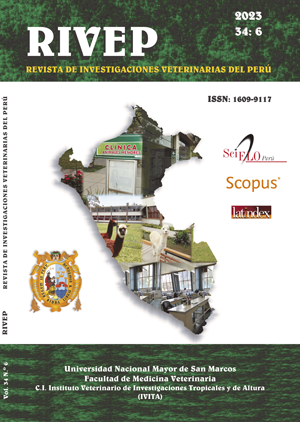Frequency of spermatozoa with caspase 3/7 activation obtained from alpaca epididymis analyzed by flow cytometry
DOI:
https://doi.org/10.15381/rivep.v34i6.26956Keywords:
spermatozoa, alpaca, flow cytometry, apoptosis, caspasesAbstract
The study aimed to determine the proportion of alpaca (Vicugna pacos) sperm cells with caspases-3/7 in an activated form. The epididymis of 23 pairs of testicles obtained from the Municipal Slaughterhouse of Huancavelica, Peru, were used. In the laboratory, an extender (fat-free milk, egg yolk and fructose) was used to obtain sperm cells from the caudal part of the epididymis. The cells were washed twice with 1 mL of PBS and centrifuged. It was added 100 µL of CellEvent™ Caspase 3/7 Green Detection Reagent to the product and incubated at 37.5 °C for 30 min, while 0.5 µL of Propidium Iodide was added 10 minutes before the end of the incubation, as a marker of cell death. The reading was done by flow cytometry. The mean ± standard deviation of sperm cells with caspase 3/7 activation was 36.21 ± 11.25%, confidence interval from 31.34 to 41.08% and a coefficient of variation of 31.07%. The data presented a normal distribution according to the Kolmogorv-Smirnov test. The correlations between spermatozoa with activated caspases 3/7 with the weight and volume of the testis and with sperm motility and concentration were not significant. It is estimated between 31 to 41% of alpaca epididymal spermatozoa are in the process of apoptosis.
Downloads
Downloads
Published
Issue
Section
License
Copyright (c) 2023 Luis Baez Oré, Carlos Segura Zevallos, José La Rosa Agapito, Alexei Santiani

This work is licensed under a Creative Commons Attribution 4.0 International License.
AUTHORS RETAIN THEIR RIGHTS:
a. Authors retain their trade mark rights and patent, and also on any process or procedure described in the article.
b. Authors retain their right to share, copy, distribute, perform and publicly communicate their article (eg, to place their article in an institutional repository or publish it in a book), with an acknowledgment of its initial publication in the Revista de Investigaciones Veterinarias del Perú (RIVEP).
c. Authors retain theirs right to make a subsequent publication of their work, to use the article or any part thereof (eg a compilation of his papers, lecture notes, thesis, or a book), always indicating the source of publication (the originator of the work, journal, volume, number and date).










